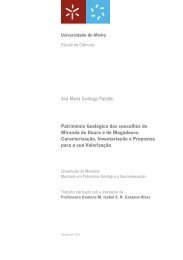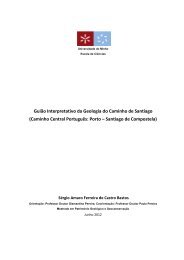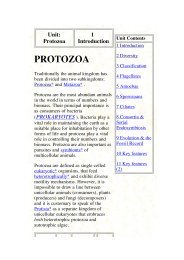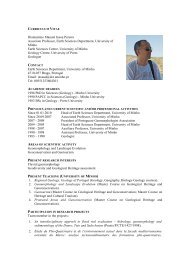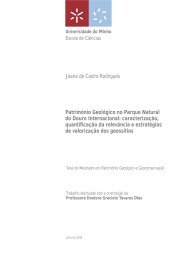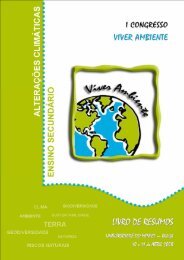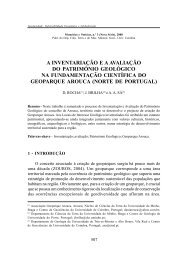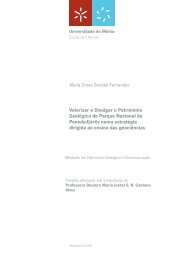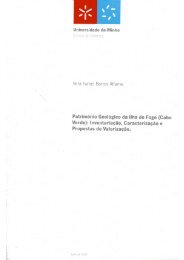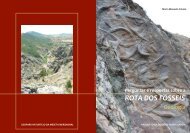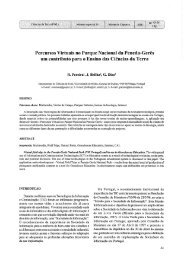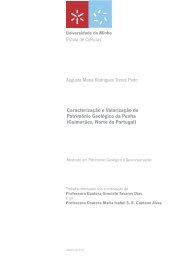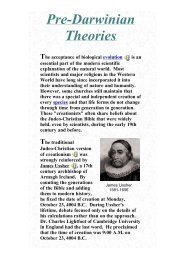Giardia lamblia: cell biology and microscopy of one of the most ...
Giardia lamblia: cell biology and microscopy of one of the most ...
Giardia lamblia: cell biology and microscopy of one of the most ...
You also want an ePaper? Increase the reach of your titles
YUMPU automatically turns print PDFs into web optimized ePapers that Google loves.
<strong>Giardia</strong> <strong>lamblia</strong>: <strong>cell</strong> <strong>biology</strong> <strong>and</strong> <strong>microscopy</strong> <strong>of</strong> <strong>one</strong> <strong>of</strong> <strong>the</strong> <strong>most</strong> primitive eukaryotes<strong>Giardia</strong> <strong>lamblia</strong>:<strong>cell</strong> <strong>biology</strong> <strong>and</strong> <strong>microscopy</strong><strong>of</strong> <strong>one</strong> <strong>of</strong> <strong>the</strong> <strong>most</strong> primitive eukaryotes.SUMMARY<strong>Giardia</strong>, a protist, is providing new insights into <strong>the</strong>evolution<strong>of</strong> <strong>the</strong> eukaryotic <strong>cell</strong> <strong>and</strong> <strong>of</strong> endoplasmic reticulum,microtubules <strong>and</strong> mitochondriaby Dr. Bohdan J. SoltysHere you will learn some <strong>of</strong> <strong>the</strong> new <strong>and</strong> exciting things about <strong>the</strong><strong>biology</strong> <strong>of</strong> protists, <strong>the</strong> <strong>most</strong> primitive eukaryotic, or non-bacterial,organisms. Recent discoveries concerning <strong>Giardia</strong> <strong>lamblia</strong> are emphasized<strong>and</strong> microscopic imaging <strong>of</strong> this organism <strong>and</strong> its sub<strong>cell</strong>ular organellesusing both fluorescence <strong>and</strong> electron <strong>microscopy</strong> is a major highlight.There is also a tribute page in honor <strong>of</strong> Keith Porter, pi<strong>one</strong>er <strong>of</strong> electron<strong>microscopy</strong>, which features comparative microscopic imaging <strong>of</strong>mammalian <strong>cell</strong>s, including human <strong>cell</strong>s, which in contrast to <strong>Giardia</strong>represent <strong>the</strong> <strong>most</strong> highly evolved eukaryotic organisms.SINCE FEB 2001CONTENTS❍<strong>Giardia</strong> HomepageI. IntroductionII. Identification <strong>and</strong> characterization <strong>of</strong> <strong>Giardia</strong>'shttp://www.geocities.com/CollegePark/Lab/4551/ (1 <strong>of</strong> 10) [2003/10/21 21:37:47]
<strong>Giardia</strong> <strong>lamblia</strong>: <strong>cell</strong> <strong>biology</strong> <strong>and</strong> <strong>microscopy</strong> <strong>of</strong> <strong>one</strong> <strong>of</strong> <strong>the</strong> <strong>most</strong> primitive eukaryotes❍❍endomembranesIII. Identity <strong>and</strong> organization <strong>of</strong> <strong>Giardia</strong>'s cytoskeletonIV. Did <strong>Giardia</strong> lose mitochondria in evolution?V. <strong>Giardia</strong> referencesVI. Links <strong>and</strong> recommended booksMicroscopy <strong>of</strong> Mammalian Cells - A Keith Porter Tribute PageAbout <strong>the</strong> AuthorI. INTRODUCTION<strong>Giardia</strong> <strong>lamblia</strong> is considered <strong>one</strong> <strong>of</strong> <strong>the</strong> deepest branching or <strong>most</strong>primitive eukaryotes in existence (see reference 1 <strong>and</strong> 2 listed below) <strong>and</strong>some scientists have called <strong>Giardia</strong> a 'missing link' in <strong>the</strong> evolution <strong>of</strong>eukaryotic <strong>cell</strong>s from prokaryotic <strong>cell</strong>s. Eukaryotic <strong>cell</strong>s, by definition, arethose containing a nucleus <strong>and</strong> include all organisms from protists up tohuman, while prokaryotic <strong>cell</strong>s are bacteria. <strong>Giardia</strong> <strong>lamblia</strong> was <strong>the</strong> firsteukaryotic <strong>cell</strong> to ever be seen using <strong>one</strong> <strong>of</strong> <strong>the</strong> first good qualitymicroscopes developed by Antonie van Leeuwenhoek, a Dutchman, backin <strong>the</strong> late 1600's. Van Leeuwenhoek was an amateur scientist with nohigher education who never<strong>the</strong>less made extraordinary contributions to<strong>biology</strong>. Although <strong>Giardia</strong> is a single <strong>cell</strong> organism, van Leeuwenhoekcalled it an 'animacule' because he thought it had an amazing similaritywith <strong>the</strong> general appearance <strong>of</strong> animals. What does <strong>Giardia</strong> look like toyou in <strong>the</strong> fluorescence micrograph below?http://www.geocities.com/CollegePark/Lab/4551/ (2 <strong>of</strong> 10) [2003/10/21 21:37:47]
<strong>Giardia</strong> <strong>lamblia</strong>: <strong>cell</strong> <strong>biology</strong> <strong>and</strong> <strong>microscopy</strong> <strong>of</strong> <strong>one</strong> <strong>of</strong> <strong>the</strong> <strong>most</strong> primitive eukaryotesAs a primitive eukaryote, underst<strong>and</strong>ing how <strong>Giardia</strong> performs basic<strong>cell</strong>ular functions will be helpful in elucidating <strong>the</strong> mechanisms present inall higher eukaryotic <strong>cell</strong>s (3, 4). In comparison, a model organism such asyeast, which many scientists study, is actually a higher eukaryote <strong>and</strong>provides information about only relatively recent evolutionarydevelopments. Also, <strong>the</strong> giardial genome is not much more complex thanthat <strong>of</strong> yeast, making its complete sequencing a feasible <strong>and</strong> deservingobjective (4). There are also applied reasons for studying <strong>Giardia</strong>. <strong>Giardia</strong>is <strong>of</strong> significant environmental <strong>and</strong> medical importance worldwide, being awaterborne pathogen <strong>and</strong> an important intestinal parasite in humans (5, 6).A few basic facts about <strong>Giardia</strong> should be menti<strong>one</strong>d. The life cycle <strong>of</strong><strong>Giardia</strong> alternates between trophozoite <strong>and</strong> cyst. <strong>Giardia</strong> lacksmitochondria <strong>and</strong> peroxisomes <strong>and</strong> until recently (see below) was reportedto also lack a Golgi apparatus <strong>and</strong> endoplasmic reticulum. The dormantwater-resistant cyst causes infection while <strong>the</strong> rapidly dividing trophozoitecauses <strong>the</strong> symptoms <strong>of</strong> giardiasis. The processes <strong>of</strong> encystation <strong>and</strong>excystation are both problems in <strong>cell</strong> differentiation. <strong>Giardia</strong> is relativelyeasy to culture <strong>and</strong> work with in <strong>the</strong> laboratory. Encystation can behttp://www.geocities.com/CollegePark/Lab/4551/ (3 <strong>of</strong> 10) [2003/10/21 21:37:47]
<strong>Giardia</strong> <strong>lamblia</strong>: <strong>cell</strong> <strong>biology</strong> <strong>and</strong> <strong>microscopy</strong> <strong>of</strong> <strong>one</strong> <strong>of</strong> <strong>the</strong> <strong>most</strong> primitive eukaryotes4. Longitudinal sections <strong>of</strong> cytoplasmic ax<strong>one</strong>mes Kinetosomes from whichmicrotubules are nucleated are seen at <strong>the</strong> top <strong>of</strong> part B.5. Electron micrographs showing labeling <strong>of</strong> <strong>the</strong> adhesive disk withantibody to acetylated tubulin. The adhesive disk is a microtubule-basedstructure only found in <strong>Giardia</strong>.Since postranslational modifications <strong>of</strong> tubulin are known tosignificantly alter microtubule assembly-disassembly dynamics, fur<strong>the</strong>rinvestigation <strong>of</strong> <strong>the</strong>se throughout <strong>the</strong> life cycle are warranted. Thus far,<strong>the</strong> cytoskeleton <strong>of</strong> trophozoites appears to be a ra<strong>the</strong>r stable structure,with all microtubules being acetylated . Future work should includeexamination <strong>of</strong> cytoskeleton dynamics during encystation <strong>and</strong> excystation,when dramatic structural rearrangements occur. Moreover, mitosis in<strong>Giardia</strong> has not yet been adequately described. Since it is no doubt <strong>the</strong>simplest mitosis in all eukaryotes, <strong>Giardia</strong> may be an ex<strong>cell</strong>ent modelsystem for underst<strong>and</strong>ing mitosis in general. The mitotic spindle is also apotential target for <strong>the</strong>rapeutic intervention in cases <strong>of</strong> giardiasis, <strong>and</strong> tests<strong>of</strong> anti-mitotic drugs would benefit from an underst<strong>and</strong>ing <strong>of</strong> <strong>Giardia</strong>'smitotic spindle physiology.IV. DID GIARDIA LOSE MITOCHONDRIA?A large number <strong>of</strong> protists, including <strong>Giardia</strong>, lack mitochondria. In <strong>the</strong>past this has been taken as evidence that <strong>the</strong>se organisms existed before<strong>the</strong> endosymbiosis event which led to mitochondria, <strong>and</strong> hence were moreprimitive than o<strong>the</strong>r protists. In endosymbiosis, a <strong>the</strong>ory made popular inits modern version by Dr. Lynn Margulis 30 years ago, oxygen respiringbacteria invaded a host <strong>cell</strong> <strong>and</strong> formed a permanent relationship livingwithin it, evolving into mitochondria. This endosymbiotic event is thoughtto have occured more than 1000 million years ago [our planetary systemformed 4600 million years ago; <strong>the</strong> first bacterial <strong>cell</strong> appeared 3900million years ago; <strong>the</strong> first protists appeared 2000 milllion years ago;man's ancestors appeared 4 million years ago]. Mitochondria in <strong>cell</strong>sactually still look like bacteria <strong>and</strong> grow <strong>and</strong> divide at <strong>the</strong>ir own pace.They even have <strong>the</strong>ir own DNA, although <strong>most</strong> genes over time have beentransferred to <strong>the</strong> nucleus.http://www.geocities.com/CollegePark/Lab/4551/ (6 <strong>of</strong> 10) [2003/10/21 21:37:47]
<strong>Giardia</strong> <strong>lamblia</strong>: <strong>cell</strong> <strong>biology</strong> <strong>and</strong> <strong>microscopy</strong> <strong>of</strong> <strong>one</strong> <strong>of</strong> <strong>the</strong> <strong>most</strong> primitive eukaryotesDespite <strong>the</strong> fact that <strong>Giardia</strong> lacks mitochondria, I <strong>and</strong> Rad Guptapublished work showing <strong>the</strong> presence <strong>of</strong> a protein related to mitochondrialhsp60 in <strong>Giardia</strong> (9). The evidence included biochemical immunoblotdetection <strong>of</strong> a protein <strong>of</strong> <strong>the</strong> correct molecular weight <strong>and</strong> bothimmun<strong>of</strong>lourescence <strong>and</strong> electron microscopic localization <strong>of</strong> reactivity atdiscrete sites in <strong>the</strong> cytoplasm.1.Immun<strong>of</strong>luorescence micrograph <strong>of</strong> <strong>Giardia</strong>.Cells were labeled withantibody against mammalian hsp60. Hsp60 is considered a mitochondrialprotein in higher eukaryotes. The fluorescent dots throughout <strong>the</strong>cytoplasm are suggestive <strong>of</strong> organelle labeling.2. Double label immun<strong>of</strong>luorescence.Hsp60 antibody labeling in A iscompared with anti-tubulin labeling <strong>of</strong> <strong>the</strong> same <strong>cell</strong>s in B. Somemicrotubule structures are identified in B: MB=median body, AF=anteriorflagella, AD=adhesive disk.Electron microscopic localization <strong>of</strong> hsp60 showed that hsp60 labelingwas in <strong>the</strong> cytoplasm <strong>and</strong> was not associated with any type <strong>of</strong> membranousstructure (not shown). To explain <strong>the</strong> findings we suggested that <strong>Giardia</strong>originally had mitochondria but lost <strong>the</strong>m in evolution. More recentstudies in <strong>the</strong> higher protist Trichomonas vaginalis, which containhydrogenosomes but no mitochondria, showed molecular evidence for <strong>the</strong>presence <strong>of</strong> mitochondrial heat shock proteins within hydogenosomes (<strong>the</strong>hydrogenosome is a double membraned redox organelle found in certainanaerobic protists). Palmer et al (10) have reviewed this work. The resultsled to <strong>the</strong> suggestion that hydogenosomes evolved (or de-evolved,depending on how you look at it) from mitochondria by a process <strong>of</strong>reductive, as opposed to acquisitive, evolution. Since <strong>Giardia</strong> has beenregarded as <strong>the</strong> <strong>most</strong> primitive eukaryote in existence, Palmer et al (10)also cite our work as evidence from diplomonads to support <strong>the</strong> idea that<strong>the</strong> earliest eukaryotic <strong>cell</strong> contained mitochondria which weresubsequently lost. Thus, <strong>the</strong> timing for <strong>the</strong> endosymbiotic event that gaverise to mitochondria is currently being pushed backwards. We are facedwith <strong>the</strong> possibility that no representative <strong>of</strong> <strong>the</strong> premitochondrial stage <strong>of</strong>eukaryotic evolution may be alive today. The endosymbiotic event thathttp://www.geocities.com/CollegePark/Lab/4551/ (7 <strong>of</strong> 10) [2003/10/21 21:37:47]
<strong>Giardia</strong> <strong>lamblia</strong>: <strong>cell</strong> <strong>biology</strong> <strong>and</strong> <strong>microscopy</strong> <strong>of</strong> <strong>one</strong> <strong>of</strong> <strong>the</strong> <strong>most</strong> primitive eukaryotesgave rise to mitochondria in fact may have occurred as far back as <strong>the</strong>very origin <strong>of</strong> <strong>the</strong> first eukaryotic <strong>cell</strong>. The key to resolving this issuewould be to obtain fur<strong>the</strong>r molecular data in <strong>Giardia</strong>. The cloning <strong>of</strong> avariety <strong>of</strong> mitochondrial proteins will be necessary. It may be verydifficult, however, to exclude lateral gene transfer <strong>of</strong> proteins fromano<strong>the</strong>r species, particularly bacterial. The proteins would have to containmitochondrial targeting sequences to definitively distinquish <strong>the</strong>m fromprokaryotic homologs.SINCE FEB 2001Material presented here is protected by copyright.V. GIARDIA REFERENCES1. Sogin, ML 1991. Early evolution <strong>and</strong> <strong>the</strong> origin <strong>of</strong> eukaryotes. CurrentOpinion in Genetics <strong>and</strong> Development 1:457-463.2. Nasmuth, K 1996. A homage to <strong>Giardia</strong>. Current Biology 6:1042.3. Gillin, F et al.1996. Cell <strong>biology</strong> <strong>of</strong> <strong>the</strong> primitive eukaryote <strong>Giardia</strong><strong>lamblia</strong>. Annual Review <strong>of</strong> Micro<strong>biology</strong> 50, 679-705.4. Lujan, HD, Mowatt, MR <strong>and</strong> Nash, TE 1997. Mechanisms <strong>of</strong> <strong>Giardia</strong><strong>lamblia</strong> differentiation into cysts. Micro<strong>biology</strong> <strong>and</strong> Molecular BiologyReview. 61:294-304.5. Marshall, MM, et al. 1997. Waterborne protozoan pathogens. ClinicalMicro<strong>biology</strong> Review 10:67-85.6. Finch, GR 1996. Water industry challenge waterborne parasites PartII. Environmental Science <strong>and</strong> Engineering 9:35,36,38.7.Soltys, BJ, Falah, M <strong>and</strong> RS Gupta. 1996. Identification <strong>of</strong> endoplasmicreticulum in <strong>the</strong> primitive eukaryote <strong>Giardia</strong> <strong>lamblia</strong> using cryoelectron<strong>microscopy</strong> <strong>and</strong> antibody to Bip. Journal <strong>of</strong> Cell Science 109:1909-1917.*See also <strong>the</strong> ‘Headlines' article entitled ‘The Primitive ER' which reviewsthis work in Trends in Cell Biology 1996. 6:378.8. Soltys, BJ <strong>and</strong> RS Gupta. 1994. Immunoelectron <strong>microscopy</strong> <strong>of</strong> <strong>Giardia</strong><strong>lamblia</strong> cytoskeleton using antibody to acetylated alpha tubulin. Journal <strong>of</strong>http://www.geocities.com/CollegePark/Lab/4551/ (8 <strong>of</strong> 10) [2003/10/21 21:37:47]
<strong>Giardia</strong> <strong>lamblia</strong>: <strong>cell</strong> <strong>biology</strong> <strong>and</strong> <strong>microscopy</strong> <strong>of</strong> <strong>one</strong> <strong>of</strong> <strong>the</strong> <strong>most</strong> primitive eukaryotesEukaryotic Micro<strong>biology</strong> 41: 625-632.9. Soltys, BJ <strong>and</strong> RS Gupta. 1994. Presence <strong>and</strong> <strong>cell</strong>ular distribution <strong>of</strong> a60-kDa protein related to mitochondrial hsp60 in <strong>Giardia</strong> <strong>lamblia</strong>. Journal<strong>of</strong> Parasitology 80: 580-590.10. Palmer, JD 1997. Organelle genomes: going, going, g<strong>one</strong>! Science275:790-791.11. Roger AJ, Svard SG, Tovar J, Clark CG, Smith MW, Gillin FD, SoginML 1998 A mitochondrial-like chaperonin 60 gene in <strong>Giardia</strong> <strong>lamblia</strong>:evidence that diplomonads once harbored an endosymbiont related to <strong>the</strong>progenitor <strong>of</strong> mitochondria. Proc Natl Acad Sci USA 95: 229-34.VI. RECOMMENDED BOOKS AND LINKSA. LINKSFor links to websites on o<strong>the</strong>r protists, its a must to check out ProtistImage DataThis site is a featured website at YAHOO! where you can find links too<strong>the</strong>r sites on model systems <strong>and</strong> microorganisms:1. http://dir.yahoo.com/Science/Research/Model_Systems/2. http://dir.yahoo.com/Science/Biology/Micro<strong>biology</strong>/Microorganisms/B. BOOKS FOR STUDENTS, HOBBYISTS AND AMATEURSCIENTISTS1. Explore <strong>the</strong> World Using Protozoa by R.O. Anderson <strong>and</strong> M. DrugerPaperback (1997) Natl Science Teachers Assn; ISBN: 0873551591; highlyrecommended.2. Guide to Microlife by K.G. Rainis <strong>and</strong> B.J. RussellPaperback (1997) Franklin Watts, Inc.; ISBN: 05311126673. How to Know <strong>the</strong> Protozoa by Theodore L. JahnPaperback 2nd edition (1979) WCB/McGraw-Hill; ISBN: 06970475984. A World in a Drop <strong>of</strong> Water : Exploring With a Microscope by A.Silverstein, V.B. Silversteinhttp://www.geocities.com/CollegePark/Lab/4551/ (9 <strong>of</strong> 10) [2003/10/21 21:37:47]
<strong>Giardia</strong> <strong>lamblia</strong>: <strong>cell</strong> <strong>biology</strong> <strong>and</strong> <strong>microscopy</strong> <strong>of</strong> <strong>one</strong> <strong>of</strong> <strong>the</strong> <strong>most</strong> primitive eukaryotesPaperback (1998) Dover Pubns; ISBN: 0486403815; Under $4!5. Antoni Van Leeuwenhoek : First to See Microscopic Life (Great Minds <strong>of</strong>Science series) by L. YountLibrary Binding (1996) Enslow Publishers, Inc.; ISBN: 08949068016. Five Kingdoms : An Illustrated Guide to <strong>the</strong> Phyla <strong>of</strong> Life on Earth by L.Margulis, K.V. Schwartz, S.J. GouldPaperback 3rd edition (1998) W H Freeman & Co; ISBN: 0716730278C. BOOKS FOR GRADUATE STUDENTS AND PROFESSIONALSCIENTISTS1. Protozoa <strong>and</strong> O<strong>the</strong>r Protists by Michael A. SleighHardcover 3rd edition (1999) Edward Arnold; ISBN: 05215736292. Protoctista Glossary by L. Margulis, H.I. McKhann, L. OlendzenskiHardcover (1999) J<strong>one</strong>s & Bartlett Pub; ISBN: 0867200812Where to next on this website?1. BACK TO THE TOP2. MICROSCOPY OF MAMMALIAN CELLS3. ABOUT THE AUTHORThis page hosted byGet your own Free Home Pagehttp://www.geocities.com/CollegePark/Lab/4551/ (10 <strong>of</strong> 10) [2003/10/21 21:37:47]
http://www.geocities.com/CollegePark/Lab/4551/fig1b.jpghttp://www.geocities.com/CollegePark/Lab/4551/fig1b.jpg [2003/10/21 21:38:07]
http://www.geocities.com/CollegePark/Lab/4551/fig2b.jpghttp://www.geocities.com/CollegePark/Lab/4551/fig2b.jpg [2003/10/21 21:38:15]
http://www.geocities.com/CollegePark/Lab/4551/giard1.jpghttp://www.geocities.com/CollegePark/Lab/4551/giard1.jpg [2003/10/21 21:38:54]
http://www.geocities.com/CollegePark/Lab/4551/fig10b.jpghttp://www.geocities.com/CollegePark/Lab/4551/fig10b.jpg [2003/10/21 21:39:00]
http://www.geocities.com/CollegePark/Lab/4551/fig12b.jpghttp://www.geocities.com/CollegePark/Lab/4551/fig12b.jpg [2003/10/21 21:39:06]
http://www.geocities.com/CollegePark/Lab/4551/fig200.jpghttp://www.geocities.com/CollegePark/Lab/4551/fig200.jpg [2003/10/21 21:39:17]
http://www.geocities.com/CollegePark/Lab/4551/fig11b.jpghttp://www.geocities.com/CollegePark/Lab/4551/fig11b.jpg [2003/10/21 21:39:29]
http://www.geocities.com/CollegePark/Lab/4551/fig21b.jpghttp://www.geocities.com/CollegePark/Lab/4551/fig21b.jpg [2003/10/21 21:39:41]
http://www.geocities.com/CollegePark/Lab/4551/fig20b.jpghttp://www.geocities.com/CollegePark/Lab/4551/fig20b.jpg [2003/10/21 21:39:49]



